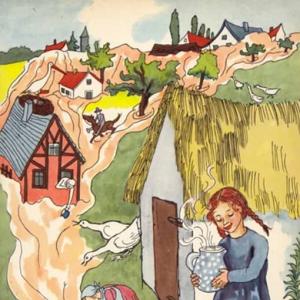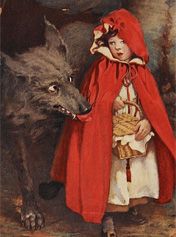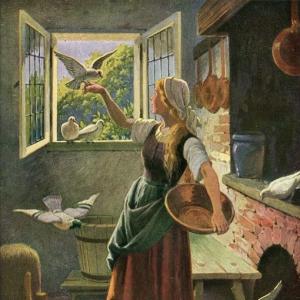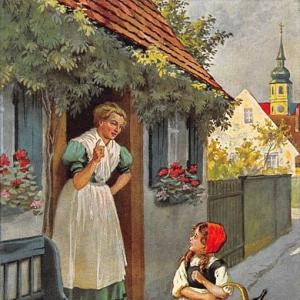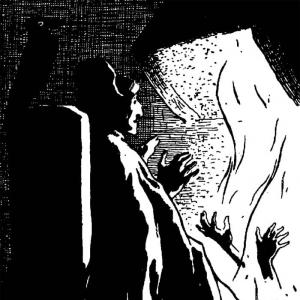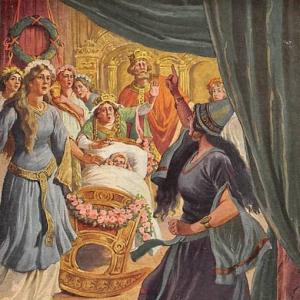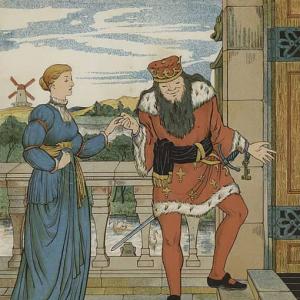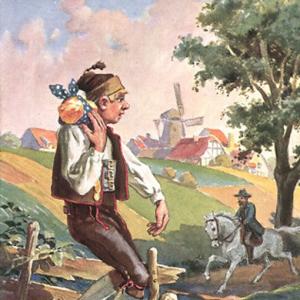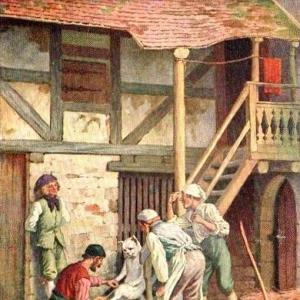Reading time: 4 min
Once on a time the fox was talking to the wolf of the strength of man; how no animal could withstand him, and how all were obliged to employ cunning in order to preserve themselves from him. Then the wolf answered, „If I had but the chance of seeing a man for once, I would set on him notwithstanding.“ – „I can help thee to do that,“ said the fox. „Come to me early to-morrow morning, and I will show thee one.“ The wolf presented himself betimes, and the fox took him out on the road by which the huntsmen went daily. First came an old discharged soldier. „Is that a man?“ inquired the wolf. „No,“ answered the fox, „that was one.“ Afterwards came a little boy who was going to school. „Is that a man?“ – „No, that is going to be one.“ At length came a hunter with his double-barrelled gun at his back, and hanger by his side. Said the fox to the wolf, „Look, there comes a man, thou must attack him, but I will take myself off to my hole.“ The wolf then rushed on the man. When the huntsman saw him he said, „It is a pity that I have not loaded with a bullet,“ aimed, and fired his small shot in his face. The wolf pulled a very wry face, but did not let himself be frightened, and attacked him again, on which the huntsman gave him the second barrel. The wolf swallowed his pain, and rushed on the huntsman, but he drew out his bright hanger, and gave him a few cuts with it right and left, so that, bleeding everywhere, he ran howling back to the fox. „Well, brother wolf,“ said the fox, „how hast thou got on with man?“ – „Ah!“ replied the wolf, „I never imagined the strength of man to be what it is! First, he took a stick from his shoulder, and blew into it, and then something flew into my face which tickled me terribly. Then he breathed once more into the stick, and it flew into my nose like lightning and hail. When I was quite close, he drew a white rib out of his side, and he beat me so with it that I was all but left lying dead.“ – „See what a braggart thou art!“ said the fox. „Thou throwest thy hatchet so far that thou canst not fetch it back again!“
 Learn languages. Double-tap on a word.Learn languages in context with Childstories.org and Deepl.com.
Learn languages. Double-tap on a word.Learn languages in context with Childstories.org and Deepl.com.Backgrounds
Interpretations
Adaptions
Summary
Linguistics
„The Wolf and the Man“ is a lesser-known fairy tale collected by the Brothers Grimm in their famous compilation „Children’s and Household Tales“ (Kinder- und Hausmärchen). This story, like many others in their collection, has its roots in European folklore and reflects the values and social dynamics of the time when it was collected.
In „The Wolf and the Man,“ the narrative focuses on a chance encounter between a wolf and a man in the forest. The wolf, upon seeing the man, is impressed by his hunting skills and decides to observe him. As the man successfully hunts various animals, the wolf becomes envious and wishes to learn how to hunt like him. However, as the story unfolds, the wolf learns that the man’s hunting prowess is not something he can easily acquire and that there is more to being a human hunter than he initially thought.
This tale touches on themes of curiosity, envy, and the differences between human and animal natures. It explores the relationship between humans and the natural world, as well as the idea that each creature has unique skills and abilities that cannot always be replicated by others.
As with many other tales collected by the Brothers Grimm, „The Wolf and the Man“ has likely evolved and changed over time as it was passed down through generations. The Brothers Grimm may have adapted the story from different regional sources, molding it into the version that appears in their collection of German folktales.
„The Wolf and the Man“ offers various interpretations that can be drawn from its narrative. Here are a few key themes that can be explored:
Underestimation of opponents: The wolf’s arrogance and ignorance lead him to underestimate the power and resourcefulness of humans. This serves as a reminder to not underestimate others and to approach situations with humility and respect.
The importance of wisdom and experience: The fox, being more experienced and wise, tries to warn the wolf about the strength of humans. The wolf’s failure to heed the fox’s advice demonstrates the significance of listening to those with more experience and knowledge.
The consequences of pride and overconfidence: The wolf’s pride and overconfidence in his own abilities lead to his painful defeat. This can be seen as a cautionary tale about the dangers of being too self-assured without understanding the full context or capabilities of one’s adversaries.
The use of cunning and intelligence: The fox is a symbol of cunning and intelligence in the story, as it understands the risks associated with confronting a human and avoids the confrontation itself. This highlights the importance of using intelligence and cunning to navigate through difficult situations.
The transformative power of experience: The story illustrates how personal experiences can change one’s perspective. The wolf, having confronted and suffered at the hands of the man, gains a newfound understanding of human strength and, presumably, learns to be more cautious in the future.
The fairy tale „The Wolf and the Man“ has inspired many adaptations and retellings over the years. Here are a few examples.
„The Hunter and the Wolf“: This is a variation of the story in which the man is a hunter and the wolf is a talking animal who tries to trick the hunter. In the end, the hunter outwits the wolf and kills him.
„The Shepherd and the Wolf“: This adaptation features a shepherd who is tricked by a talking wolf. The shepherd initially trusts the wolf and allows him to enter his flock, but he later realizes his mistake and kills the wolf.
„The Wolf and the Shepherd“: In this version, the wolf and the shepherd become friends and travel together. However, the shepherd eventually betrays the wolf and kills him.
„The Wolf and the Seven Kids“: This is a well-known fairy tale in which a wolf disguises himself as the mother of seven young goats and tries to eat them. The story has similarities to „The Wolf and the Man,“ as both tales involve deception and betrayal.
„The Fox and the Cat“: This is a fable by Aesop that shares some similarities with „The Wolf and the Man.“ In the fable, a fox and a cat discuss their various talents and come to the conclusion that it is better to have one skill that you are good at than to have many skills but be mediocre at all of them.
These are just a few examples of the many adaptations of „The Wolf and the Man“ that exist. The story’s themes of trust, betrayal, and violence have resonated with readers and storytellers throughout history, and it continues to inspire new retellings to this day.
„The Wolf and the Man“ is a fairy tale by the Brothers Grimm that tells the story of a curious wolf who wants to see and challenge a man, despite the fox’s warning about human strength. The fox agrees to help the wolf and leads him to a road where huntsmen pass daily.
Initially, the wolf sees an old discharged soldier and a young boy, neither of whom meet his expectation of a man. Finally, they come across a hunter armed with a double-barrelled gun and a hanger. The fox takes this opportunity to leave the wolf to confront the man alone.
The wolf, undeterred by the hunter’s weapons, charges at the man. In response, the hunter shoots small shots at the wolf, causing discomfort but not stopping the animal. The wolf continues to attack, and the hunter uses the second barrel of his gun. Despite the pain, the wolf persists in his assault, prompting the hunter to draw his hanger and slash at the wolf, leaving him bleeding and in pain.
Defeated and wounded, the wolf retreats to the fox, lamenting the unexpected power of man. He describes the shots from the gun as tickling and painful and the hanger as a white rib that left him nearly dead. The fox mocks the wolf for underestimating the strength of man and highlights the consequences of his bravado.
The fairy tale „The Wolf and the Man“ by the Brothers Grimm presents an interesting opportunity for linguistic analysis. Let’s break down some key aspects of its language and structure:
Narrative Structure
Fable-like Simplicity: The tale follows a straightforward, linear narrative typical of fables. The sequence of events is clear, with the fox promising to show the wolf a man, leading to the wolf’s encounter with the huntsman, and concluding with a lesson.
Character Types
The story uses archetypal characters: the cunning fox, the brash and impulsive wolf, and the hunter as the embodiment of human strength and cunning. Each character is defined by a single, prominent trait, a common feature in fables.
Dialogue: Dialogue is used to advance the plot and to reveal character motivations. The speech of the fox and the wolf is simple and direct, reflecting their straightforward, unadorned thought processes. The fox’s language suggests cunning and manipulation, whereas the wolf’s language expresses bravado and subsequent disillusionment.
Thematic Elements
Human Superiority: A central theme is the superiority of human intellect and technology over brute strength. The wolf learns that humans, despite appearing less physically imposing, possess tools and cunning that animals cannot match.
Cunning vs. Strength: The fox’s cunning is contrasted with the wolf’s reliance on physical strength. This reflects the broader theme of wit over brawn, common in many of Grimm’s tales.
Deceptive Appearances: The wolf’s failure stems from judging the strength of a man solely by physical appearance. The tale suggests that true power lies not in physical strength but in knowledge and tools.
Descriptive Language: The physical encounter between the wolf and the huntsman is depicted with vivid imagery. Phrases like „blew into it, and then something flew into my face“ convey the sensory confusion experienced by the wolf.
Metaphor and Simile: The language includes metaphorical expressions, like „threw a white rib out of his side“ to describe the hanger, providing a fantastical element typical in fairy tales.
Idiom and Expression: The fox’s final line, „Thou throwest thy hatchet so far that thou canst not fetch it back again,“ is a metaphorical idiom suggesting that boasting leads to one’s downfall. Such expressions enrich the moral lesson of the tale.
Moral and Interpretation
The Brothers Grimm often embed moral lessons in their stories. Here, the moral can be seen as a warning against underestimating others based on appearances and trusting too much in one’s raw strength over strategic thought and preparedness.
Overall, the tale uses simple language and structure to convey complex themes about human nature, intelligence, and the limits of physical power, all delivered through the interactions between anthropomorphized animals.
Information for scientific analysis
Fairy tale statistics | Value |
|---|---|
| Number | KHM 72 |
| Aarne-Thompson-Uther-Index | ATU Typ 157 |
| Translations | DE, EN, DA, ES, FR, PT, IT, JA, NL, PL, RU, TR, VI, ZH |
| Readability Index by Björnsson | 25.7 |
| Flesch-Reading-Ease Index | 89.5 |
| Flesch–Kincaid Grade-Level | 4.5 |
| Gunning Fog Index | 7.3 |
| Coleman–Liau Index | 6.7 |
| SMOG Index | 7.2 |
| Automated Readability Index | 4.1 |
| Character Count | 2.076 |
| Letter Count | 1.561 |
| Sentence Count | 27 |
| Word Count | 408 |
| Average Words per Sentence | 15,11 |
| Words with more than 6 letters | 43 |
| Percentage of long words | 10.5% |
| Number of Syllables | 492 |
| Average Syllables per Word | 1,21 |
| Words with three Syllables | 13 |
| Percentage Words with three Syllables | 3.2% |

 Facebook
Facebook  Whatsapp
Whatsapp  Messenger
Messenger  Telegram
Telegram Reddit
Reddit